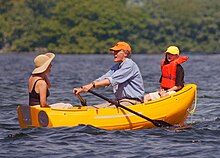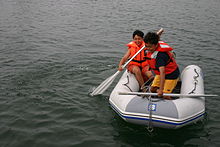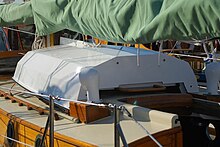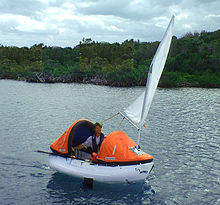
A dory is a small, shallow-draft boat, about 5 to 7 metres or 16 to 23 feet long. It is usually a lightweight boat with high sides, a flat bottom and sharp bows. It is easy to build because of its simple lines. For centuries, the dory has been used as a traditional fishing boat, both in coastal waters and in the open sea.
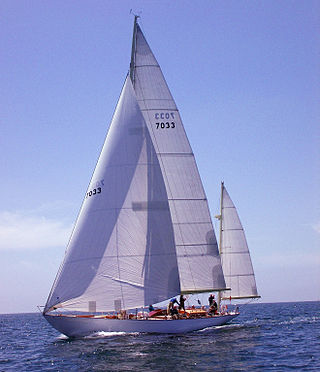
A yawl is a type of boat. The term has several meanings. It can apply to the rig, to the hull type or to the use which the vessel is put.
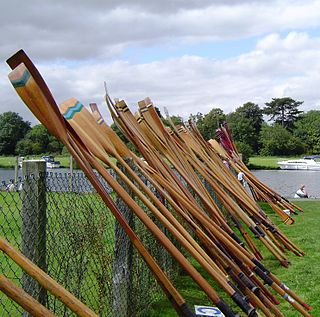
An oar is an implement used for water-borne propulsion. Oars have a flat blade at one end. Rowers grasp the oar at the other end.

Boat building is the design and construction of boats and their systems. This includes at a minimum a hull, with propulsion, mechanical, navigation, safety and other systems as a craft requires.

Boating is the leisurely activity of travelling by boat, or the recreational use of a boat whether powerboats, sailboats, or man-powered vessels, focused on the travel itself, as well as sports activities, such as fishing or waterskiing. It is a popular activity, and there are millions of boaters worldwide.
This glossary of nautical terms is an alphabetical listing of terms and expressions connected with ships, shipping, seamanship and navigation on water. Some remain current, while many date from the 17th to 19th centuries. The word nautical derives from the Latin nauticus, from Greek nautikos, from nautēs: "sailor", from naus: "ship".
The Jersey Skiff is a beach launched boat first appearing around the end of the 19th century. They were first used as fishing boats, to be launched through the surf, sailed to the fishing grounds and then retrieved through the surf.

Rowing is the act of propelling a human-powered watercraft using the sweeping motions of oars to displace water and generate reactional propulsion. Rowing is functionally similar to paddling, but rowing requires oars to be mechanically attached to the boat, and the rower drives the oar like a lever, exerting force in the same direction as the boat's travel; while paddles are completely hand-held and have no attachment to the boat, and are driven like a cantilever, exerting force opposite to the intended direction of the boat.
The Fatty Knees fibreglass sailing dinghies were designed by Lyle Hess (1912–2002). Produced in 7’ (2.1m), 8’ (2.4m) and 9’ (2.7m) long models. The 8’ model has a 4’ (1.2m) beam. Primarily designed as a yacht tender with good rowing and towing characteristics, the boat can be sailed, with enough width in the beam to provide stability.
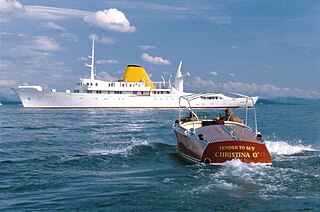
A yacht tender is a vessel used for servicing and providing support and entertainment to a private or charter yacht. They include utilitarian craft, powered by oar or outboard motor, and high-speed luxury craft, supporting superyachts, powered by inboard engines, some using water-jets. Some superyachts have a support vessel that follows them with bulky items that are not conveniently stowed aboard the main yacht, such as a helicopter, automobile or larger watercraft.

A trailer sailer is a type of sailboat that has been designed to be easily transported using a boat trailer towed by an automobile. They are generally larger than a sailing dinghy. Trailer sailers include day sailers and small cabin cruisers, suitable for living on.

In some boats and ships, a transom is the aft transverse surface of the hull that forms the stern of a vessel. Historically, they are a development from the canoe stern wherein which both bow and stern are pointed.

A ship's boat is a utility boat carried by a larger vessel. Ship's boats have always provided transport between the shore and other ships. Other work done by such boats has varied over time, as technology has changed. In the age of sail, especially for warships, an important role was the collection of drinking water. The use of radio, followed by telex, e-mail, etc. has reduced and then replaced the need for written communications to be delivered. A large enough boat may be needed to carry an anchor to some distance away from the ship, so as to kedge out of a harbour or away from a hazard – and also to recover such an anchor afterwards. Warships have always used their boats as an extension to their military role. This includes the provision of a means of escape for the crews of fireships, the landing of troops, or the "cutting out" raids that were used by the Royal Navy, especially during the Napoleonic Wars. All these requirements competed with the need to be able to stow the boats on board in a way that did not interfere with the normal operation of the ship.
Seahopper is a brand of wooden folding boats, built in Wellington, Somerset, England. Since 1974, more than 7000 Seahoppers have been built in this yard. Seahoppers are built from plywood, with a PVC membrane.
The Shrimp is a Canadian dinghy that was designed by Hubert Vandestadt and Fraser McGruer and first built in 1972. The boat was designed to employed as a powered yacht tender, a rowboat or as a sailing dinghy.

The Skunk 11 is a Canadian utility dinghy that can be rowed, used as a motorboat, fishing boat or as a sailing dinghy. It was designed by Hubert Vandestadt and first built in 1969.

The Echo 12 is a Canadian rowboat, motorboat and sailing dinghy that was first built in 1979.
The Puffer is an American rowboat, motorboat and sailing dinghy that was designed by Fred Scott and first built in 1972.
The Dovekie 21, often called just the Dovekie, is an American sailing dinghy, named for the sea bird. It was designed by Phil Bolger as a cruiser and first built in 1978.
This glossary of nautical terms is an alphabetical listing of terms and expressions connected with ships, shipping, seamanship and navigation on water. Some remain current, while many date from the 17th to 19th centuries. The word nautical derives from the Latin nauticus, from Greek nautikos, from nautēs: "sailor", from naus: "ship".

